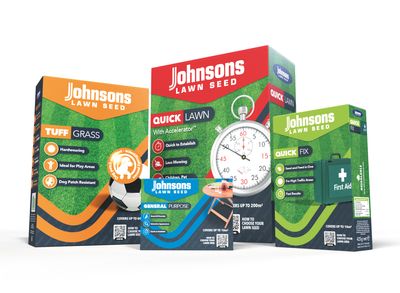Repair a Patchy Lawn by Overseeding
Published:
Read Time: 4 mins
As winter gives way to spring, the critical eyes of house and garden-proud Brits will turn to the state of their lawns, their thoughts on the possibility of outdoor entertaining. It might have rained for almost every Easter break since time began but hope’s springs eternal and we need our grass to ready for picnics and Pimm’s! The experts at Johnsons Lawn Seed – Britain’s largest and most historic producer of lawn seed – explain how it’s done.
The average lawns lose up to a quarter of their grass each year and can end up looking very patchy and unloved, but there is an easy way to revive them: Overseeding. Professional gardeners and groundsmen have been in on the secret for long ages and know that by sowing new seed into existing lawns at the appropriate time they can help transform scrubby brown areas into lush green grass again and prevent invasive weeds from taking over.
This restorative work should be carried out either in spring or late summer/early autumn and – much like everything else in our green and pleasant land - is somewhat dependent upon the weather.
Preparing Ground for Overseeding
1. Remove debris: Clear the lawn’s surface and when it is completely dry mow it as closely as you can.
2. Scarify the lawn: Rake over with a spring tine or leaf rake to break up any matted grass or thatch. If the lawn area is fairly large or the thatch very thick, you can make life easier with a scarifying power tool. You can do this in either spring or autumn but there is an extra benefit to scarifying in autumn as it will stimulate the runners and side shoots of grass to develop.
3. Aerate the lawn: De-compact soil, which you can achieve by spiking with a hollow tine fork to a depth of about 15cm (6 inches).
4. Apply a layer of good quality topsoil: Take care to fill all the holes you created in step 3. This process ensures that air, water and nutrients are able to penetrate further into the ground, enabling the swift establishment of deep, dense grass roots.
5. Level-out any small hollows: Do this with topsoil, using enough soil for grass tips to just poke through. Allow grass to grow fully through and repeating the process until the hollow is completely filled.
6. Incorporate lawn fertiliser: Johnsons Lawn Thickener or Johnsons Quick Fix seeds are already coated or mixed in with fertiliser, but if you are using a different lawn seed mix then apply fertiliser the same day as sowing or up to a few days later. Neudorff’s Organic CleanLawn is a good choice here and you should scatter it evenly over the lawn and rake in to ensure even distribution, taking care to follow the manufacturer’s instructions. Ideally you would water in fertiliser at the same time as watering the lawn seed.
7. How much seed to use: Check the manufacturer’s instructions first but, in general, 25 - 35g of lawn seed will be needed per sqm. This means you can estimate the quantity of seed that will be required by calculating the size of your lawn in square metres and multiply by the sowing rate.
8. Apply Seed: You can either do this directly from the seed packet or mixed in a bucket with some topsoil, so it doesn’t blow away or land in clumps. You can have a test run by measuring out enough seed for a 4 sqm patch (100g at a rate of 25g per sqm), then scatter it evenly from side to side and up and down. Use the same method to overseed the entire area which requires overseeding.
9. Rake and Roll: Once the whole areas is overseeded, rake it over gently then lightly roll or tread in to ensure the seed is firmly embedded and in close contact with the soil. This is necessary for good germination and grass establishment.
10. Keep Moist: The overseeded area should not be allowed to dry out, but don’t water it until the seed is firmed in or the seed will stick to your roller and shoes. If dry weather follows the overseeding, sprinkle generously with a fine spray in the evening, or when the sun has cooled. The seedbed should be kept constantly moist while grass is establishing.
11. Keep off the Grass: Try to keep away from the newly overseeded area for as long as possible to give the young and tender grass shoots a chance to get stronger.
12. The First Cut: When your new grass has reached 5-8cm (2-3 inches) in height you can cut it for the first time, trimming very lightly at first with blades on the highest setting. As the season progresses you can gradually lower blades to an ideal cutting height of 50mm (2 inches) – 25 mm (1 inches) for ryegrass mixtures and 25mm – 13 mm for non-ryegrass mixtures. You can mow regularly, but don’t remove more than a third of the growth at any one time. If existing grass needs a cut before the new grass you can raise the cutting height on your mower so it lops off the old shoots whilst leaving the new intact.
13. Wait until the sun is shining then apply Pimm’s and Picnics!
Find out more
To find out more about Johnsons Lawn Seed products please visit http://www.johnsonslawnseed.com/product-range.aspx
Ends
Editors notes
Established in 1820 Johnsons Lawn Seed is the oldest lawn seed brand in the UK with a long and prestigious record of product innovation and grass breeding.


